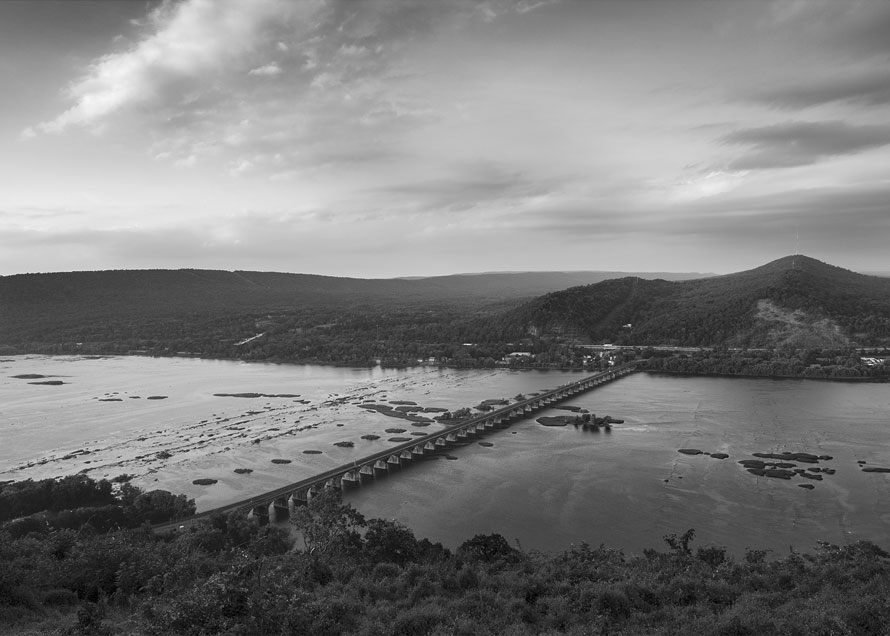
Michael Froio is a photographer who focuses on the history of the industrial era and its relation to the modern landscape. His work has been published by the National Railway Historical Society, and he has presented lectures for the Center For Railroad Photography & Art, the Library Company of Philadelphia, and chapters of the National Railway Historical Society and Pennsylvania Railroad Technical & Historical Society. Michael teaches photography at Drexel University and manages the school’s darkroom and photography facilities. Michael’s work may be seen on his website
Edd Fuller, Editor, The Trackside Photographer–Michael, I want to thank you for your generosity in sharing your work with our readers and for taking the time to talk with us. I usually start by asking about your interest in railroads, and we will get to that later, but first let’s talk about photography. You have chosen a career in photography. How did that come about?
Michael Froio – Thanks, Edd, It is a pleasure, and honor, to share my work with the Trackside Photographer, I have a tremendous amount of respect for what you are doing.
How did I get into photography? Hm. Well, I always had an interest in making photographs, at least since my young teenage years. At that time it very simply tied into my interest in trains. I wasn’t particularly good at making train photos, but while exploring the railroad (often with my father) I was always compelled to document what we found. When I started college, I had no idea what I wanted to be when I grew up. Taking prerequisite classes like English lit and math classes bored me out of my mind. A friend and classmate mentioned he was taking a photo class, so I enrolled in Photo 110. My professor, Rachael Fermi (granddaughter of Enrico Fermi – the creator of the atomic bomb) was an incredible character. She did a terrific job teaching the foundations of photography while encouraging creativity, craft and an understanding of composition. After a few classes, I took a job as a lab monitor, mixing chemicals and managing the darkroom, typically during the evening hours. It was during this post that I fell in love with photography and the idea of teaching.
Moving on from Community College, I enrolled in Drexel University’s Photography Program. I found Drexel’s program was a perfect balance of technical and creative instruction; not an art school type program, but a curriculum focusing on how to visually communicate through photographs, and that they could function in both a commercial or fine art context. I think the course that had the most significant impact on me was the Large Format class. It was a challenging course technically (I still hold the record for reshoots of my exposure and development test for the zone system) but by far the most rewarding, producing these large, 4×5” negatives. After graduating, I began work in the field as Assistant Facilities Manager at the Drexel Photo Program, and was then promoted to Facilities Manager. Working in an environment I’ve been invested in has been incredibly rewarding, including being part of bringing the 10,000sq. ft. facility into the 21st century, several lab re-designs and helping develop an evolving curriculum. I am also very fortunate to have the opportunity to teach in the Program, including foundation coursework for our majors, and an Advanced Black & White Printing course, among others. Drexel not only helps me to sustain my family and provides an opportunity to teach, but also affords me the ability to pursue my personal work, allowing me to find my purpose in photography.
Edd – Much of your photography has focused on the industrial landscape and architectural history. What sparked that interest?
Michael – As an artist, you go with your gut. I responded to these types of places without knowing why, but from the first time I composed an image of a building or landscape, the gears were turning. What is it about this site? Why am I compelled to make a photo here? It’s intuition at first, the eye sees something long before the mind connects the dots. I had to sort of go with it. It took time to understand that my interest in photographing a landscape or type of architecture comes from a fascination with our history, whether civic, industrial, or social. It took time to see the inter-relatedness of civic institutions, industry and architecture; to see that public buildings spoke to the wealth, power, progress and civic pride cities large and small shared, but that purpose-driven industrial architecture and landscapes were the working class spaces behind that civic pride. This notion still compels me to make photographs today, whether along the Main Line or anywhere else; our country’s history is a significant thread that continues to weave throughout my creative work.
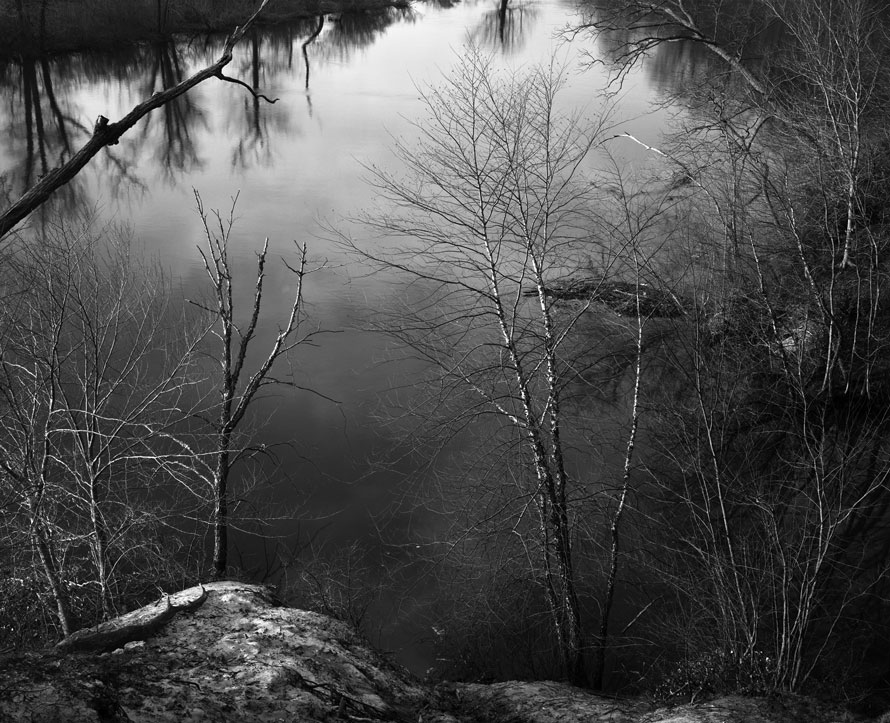
Edd – On your website, I particularly enjoy the photography in The Watershed Project which is not about railroads. You write that it “ is about the beauty of the benign and unremarked place, challenging our perception of the natural landscape . . .” This seems to apply to your railroad photography as well. Tell us a bit about this project, and how it fits with your overall vision of the landscape.
Michael – The watershed project was a logical progression of my senior thesis work, both of which largely took place in Southern New Jersey and the Delaware Valley. For thesis, I was looking at the open spaces of Salem and Cumberland Counties, mainly farmland, recognizing that such space has unfortunately become rare in the so-called Garden State. Through work on that project, I began taking notice of beautiful, unconstructed spaces of a wholly different type in the same region, mainly along the Delaware River and Bay. They were undefined areas, places that didn’t seem to have a purpose on their face, but where locals would hike, hunt, fish, etc. Were these preserved spaces? Did they belong to a more extensive network? What was the purpose of these places? How did these swaths come to exist? As I continued to examine these areas, I expanded my reach into less idyllic places, where these fringe, improvised landscapes abutted industry – airports, refineries, or dredging dumps. These were the places you might see from a highway, seemingly barren spaces. Yet, once you entered them and escaped the noise of the neighboring areas I found many were incredibly beautiful, seeming more pristine and isolated than any number of curated, patrolled, trafficked National or State Park areas. All these places made me think more and more about how we perceive the landscape around us. We understand farmland; it has a purpose, it produces a tangible result, as do industrial spaces. Parks are designed for recreation, cities and town centers are designed to serve the needs of their populations. But these unremarked tracts remain mostly undefined. The French term Terrain Vague highlights the idea that these spaces represent a diversion from our traditional understanding of the landscape and how we as a society identify with and interface with these areas. They are landscapes that may have once had a purpose but have become places void of definition – neither park, nor act of preservation nor productive, planned, commercial or social spaces. Yet they become places where only locals with intimate knowledge of the area have reason or standing to redefine the area with no need of a formal plan. The Watershed project and the previous works that lead to it, were an important part of learning how to understand and interpret the landscape.
Edd – Your work encompasses many different aspects of industrial and architectural history, but the railroad seems to hold pride of place. How did your interest in railroads come about?
Michael – While it is all interrelated, the railroad is at the beginning of it all, it was what compelled me to pick up a camera in the first place. The work featured on my website is organized in three succinct portfolios and speaks to an evolution of sorts in the way I work, the Main Line Project being the current capstone. It started with a desire to better understand the landscape, which came with the Watershed portfolio and all previous projects that led me there. The Relic portfolio helped to develop an understanding of how to weave history into creative works, and how photography can be a documentation tool while still being original. The Main Line Project was the culmination of those ideas, as well as countless other creative discoveries that have come as result of the ongoing work.
Edd – How did the Main Line Project come about?
Michael – The idea of the Main Line project was not a new one; in fact, I started it initially as my thesis work, and failed miserably because I didn’t understand what it was that I wanted to portray within the concept of the railroad itself. When I began the Main Line Project, in 2007, six years after that failure, the first year of photographs barely acknowledged the railroad at all, instead focusing on towns and industry along the line. It was my usual approach from work on the Watershed and Relic projects, but in a different environment. It wasn’t until I read an essay by John Stilgoe and his seminal book The Metropolitan Corridor that a light went off. Stilgoe’s concepts of breaking down and understanding constituent elements within the whole of the railroad landscape were right there in front of me, and I had been photographing these attributes without even realizing it. Remember that whole gut reaction first then the mind connects the dots? Well, here I was. Not long after that discovery, I began looking at ways to expand the reach of the project, ways to better connect the contemporary work within the historical framework of the subject. I found the research aspect of the project was generating as much excitement for me as being out in the field making photographs. As a result of my research, my imagery was more informed, my work process was more productive, and my viewpoint was evolving. As a result, the railroad itself began to play a more prominent role in the project since it takes, as you say, pride of place, the very thing that sparked this whole photography thing for me.
I have always considered the railroad as a sort of linear history corridor
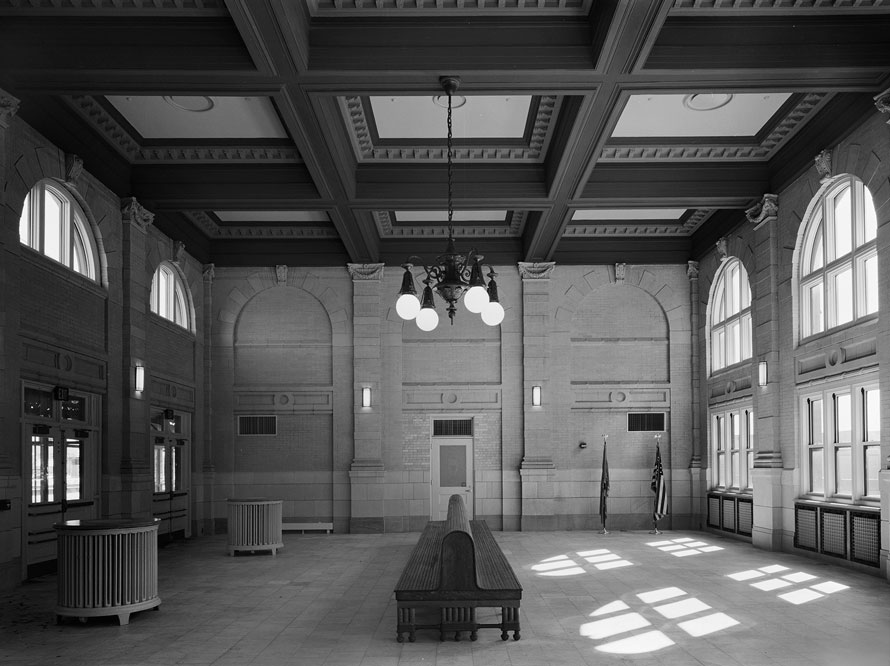
Edd – Your photographs in From the Main Line reflect the history of a railroad, but that history is interpreted in the context of the current landscape, which your black & white photographs capture beautifully. I sense though that your interest in the Pennsylvania Railroad extends beyond the railroad itself. What does the railroad tell us about the culture and history that lies along the tracks?
Michael – The railroad is the thematic tie that binds the project together (if you’ll pardon the pun), but for me, since the Pennsylvania Railroad ceased to exist well before my time, it’s the remaining contemporary landscape rather that reflects back to the railroad and its connections to neighboring towns and the landscape. For example, in the modern context, the railroad is often just passing through, void of any link to the town. In other places, there survives just a fragment from a more significant system or merely a scar in the landscape. I have always considered the railroad as a sort of linear history corridor, and along that tangent, one can learn how settlements were founded, thrived, withered, centralized and so on. This inhabited landscape repeats over and over again, showing the once significant relationship between the railroad and these cities and small towns, all through the back lots of America. It is also important to recognize that the railroad wasn’t always the first connection between these towns; early trade routes, canal systems, and other vital parts of early civilization and commerce all intertwined with the railroad corridor. All of these elements in the landscape create a dialogue, my job as a photographer is to interpret those connections, all the while making meaningful photographs.
Edd – You mention the work of William H. Rau as having influenced your work, How do Rau’s late 19th and early 20th century photographs of the Pennsylvania Railroad inform your 21st century understanding?
Michael – Every year, I give a lecture to one of our resident faculty member’s Photo History Classes, about the dialog between contemporary and historical works of art. The lecture is held at the Library Company of Philadelphia, where the Rau collection is on deposit. The visit gives students an opportunity to see how historical works can influence contemporary imagery, placing side by side Rau’s original prints commissioned by the PRR with my own. The discussion of dialog, in my case with Rau’s work, has been a multifaceted and informative relationship.
In 2003 I first discovered Rau’s work when visiting an exhibition at the Library Company titled “Traveling the Pennsylvania Railroad.” I wasn’t particularly captivated by 19th Century work at the time, but the press images looked great, and the subject certainly could not be rivaled. My knee-jerk reaction to this work was, “Wow! How could work made over 120 years ago feel so contemporary?” I loved that his work was about the railroad, but distinct from any work I had ever seen previously. In all books or publications I’d been exposed to, the train itself took a prominent role in the photograph. I found Rau’s work so compelling in its difference from this paradigm in that Rau’s work focused on the destination, the engineering marvel of the railroad itself and how it brought order and civility to the landscape. The train itself was secondary, it was more of a harmonious, “machine in the garden” if you will. Of course, I bought the book that accompanied the exhibition and studied the images. That show in 2003 planted the seed that led me back to the railroad when I applied for a grant with the Center for Emerging Visual Artists to begin the Main Line project in 2007.
Previously, I mentioned when I started the Main Line project my work focused more on the landscape, hardly acknowledging the railroad, something I had not quite figured out how to incorporate subtly. I turned to the Rau Collection at the Library Company of Philadelphia for insight, contacting Prints and Photographs Curator Sarah Weatherwax, who was very gracious with her time, allowing me to study reference prints and then later Rau’s original mammoth plate albumen prints. Having Rau’s work in front of me, one on one, was pivotal, it was like a recharge of the creative battery in between photo trips. Rau’s work as a photographer was spectacular; they were crisp, sharp gorgeous prints, gleaming with information. More importantly, the content helped me understand a railroad that was becoming worthy of its self-proclaimed title, “The Standard Railroad of the World,” with details of the railroad’s extensive system-wide improvements carefully tucked away in corners of these massive photographic prints.
I continue to take inspiration from Rau today, but I’ve also turned to his predecessors, like Purviance and Gutekunst who were also commissioned to photograph the PRR in earlier times. Outside of the PRR commissions, photographers like William Henry Jackson, AJ Russel, and Carleton Watkins who were being commissioned to document the opening of the west by rail also provide great insight on how the railroad changed our relationship with the landscape.
There is nothing more exciting on a day shooting than being enroute to a location at dawn, and that morning light is playing in the clouds, or across the trees.
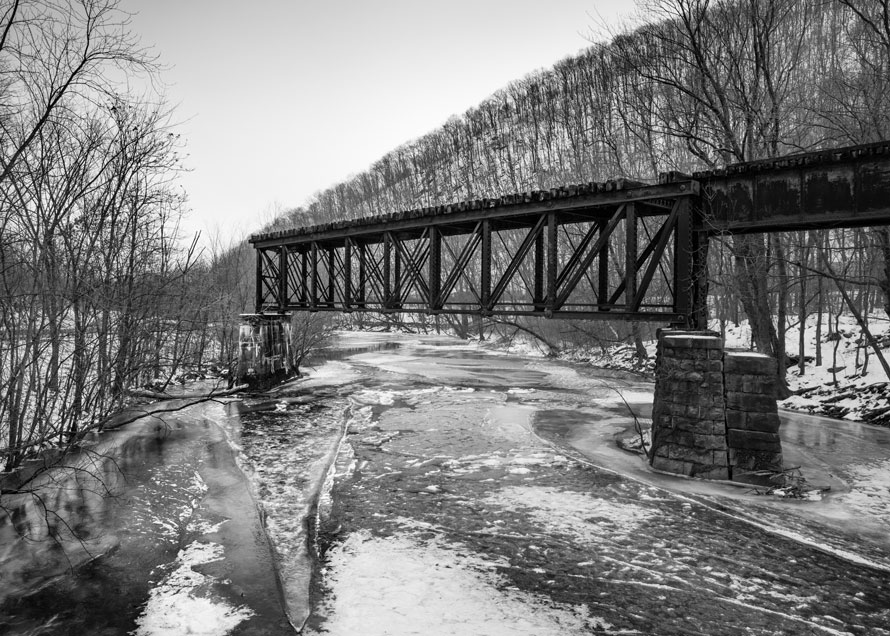
Edd – I know that a lot of research goes into a project like “From the Main Line.” Tell us about your working methods in the field. What do you look for? What draws you into a scene. Do you know where you are going to shoot in advance, or do you find your photographs while exploring the area?
Michael – I have found a synergy between what I like to call armchair scouting, historical research and my fieldwork. There is obviously a great deal of initial planning, especially since I often have limited time to travel. I do most of my scouting on Google Maps, saving and marking locations, based on previous visits, target locations, or intriguing names or landmarks within the landscape. I’ll note what time of day the light is right for a particular area, say a prayer to the cloud gods, and then start planning a trip. When I get out in the field, I do reference the maps, but the serendipity of discovery in the field is also very important. I can’t tell you how many times I have obsessed over a location only to get there and be disappointed, but on the way to that place find some incredible scene. Research indeed informs and helps to plan a trip, but I still rely on my intuition in the field while making photographs.
Its tough to say what draws me in to a particular scene; Sometimes it’s a subject, whether it be a relic or landmark of the railroad, town or a natural feature. There are however, with in those more spontaneous moments, the combination of light, feeling, and often a sense of scale or a dramatic play between the railroad and surrounding landscape that will make for a great image. There isn’t a specific formula that I can say goes into making an image like this, but there is nothing more exciting on a day shooting than being enroute to a location at dawn, and that morning light is playing in the clouds, or across the trees. That first photograph of the day is always critical, once it happens, its game on until the end of the day.
Outside of shooting or actively planning a trip, I am constantly analyzing my work, looking at prints or even on screen, conducting a mental audit of an area, looking to decide if I have enough work to convey a sense of place to a given area, before I move on to other locations. So far I haven’t been able to just turn my back on an area and say “I’m done here,” but the goal is to convey a story for each region or division within the project, touching on the character of the landscape, towns and the defining attributes of the railroad itself.
Edd – There is a consistency of vision in your black and white work that forms a strong unifying element in “From the Main Line” Most of this work is done in large format film. What prompted you to work in this way? What does large format black & white film bring to the project?
Michael – I don’t want to demystify the notion that large format has a great deal to do with the product, but to be honest, as I look back and begin to incorporate more and more digital capture I realize it was more my approach, composition, and style, that unify the work. Large format for me is a tool; at the time I started the project it was the main tool I used simply because digital wasn’t there yet, not for me. How can you justify trading a 5×7 negative for a 20 megapixel camera? You can’t; they aren’t even in the same ballpark. There are merits of the large format camera and I do love using it, as it provides a wonderful connection to the craft of making photographs. But once I started working with the advancing technology of digital capture in depth, during my commissioned work for Conrail I began to see how powerful this tool could be when used correctly.
When I commit myself to change like moving to digital, it’s after I have weighed all benefits and drawbacks of each tool. I have a few friends I will often confide in, who are not necessarily photographers, but people who will give me their honest opinion, whether I like it or not. One of these people, Anthony, a dear friend, who would often roll his eyes and harass me when the digital camera came out, sat down one evening with some work prints I made. He had never seen any of the digital work printed, just either on camera or on a laptop after a day of shooting. He sat there quietly thumbing through the prints, sighed and looked at me and said, “you’re right, the change to digital has not impacted your vision, your work, not in a negative anyway.” That was the confirmation that my transition into using digital capture was successful. A change in tool didn’t impact my vision. There are a lot of people who will argue the merits of film or digital, but after many years making pictures, the results are what matter to me. The tool you use to make pictures, whether it has a sheet of film loaded in it or a 50mp sensor, makes no difference to me, as long as you do it well.
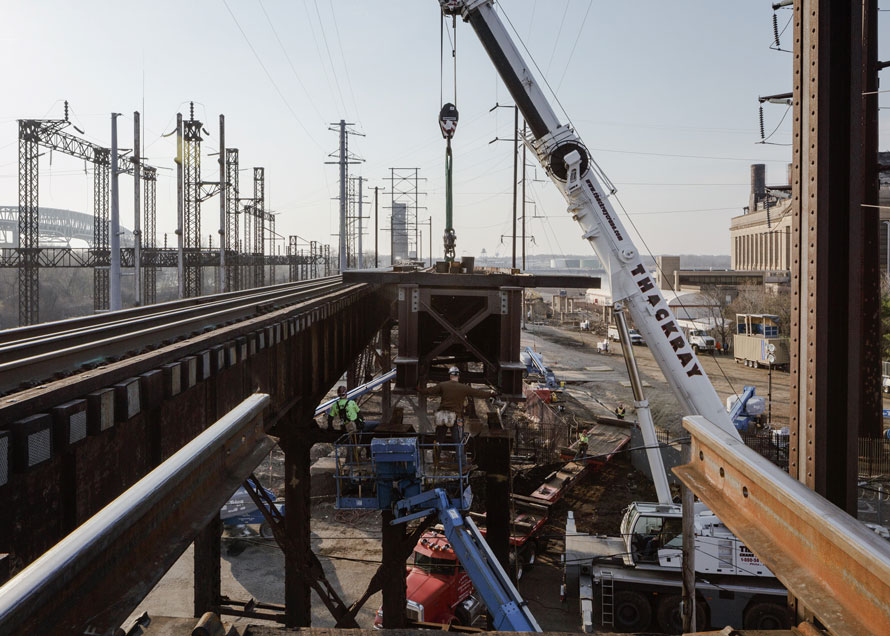
Edd – Several years ago, you were commissioned by Conrail Shared Assets to document the reconstruction of the Delair Bridge in New Jersey. From black & white view cameras to color video production is quite a leap, but you bring it off beautifully. Tell us about how this project came about and how you decided on the best way to tell this story.
Michael – The commissioned work for Conrail Shared Assets came from a working relationship with, and mutual respect for, railroad engineering and history within the company’s engineering department. When I was first approached about the span replacement project at Delair, a video was being considered to document six 3-day, 72-hour outages which were being planned over a 15 month period. 72 hours of video per outage meant 432 hours of raw footage. Who has the time to watch that, never mind the resources to archive, cull from, and edit such a massive collection? Did they want a feature film as a result? We proposed instead the use of time-lapse, essentially taking sequences of still photos at timed intervals, then processing the stills into video clips. We could still convey the scope of work while touching upon all the needs of the client, and each outage could be distilled down to a three or six-minute edit.
There was, however, one minor hitch. At the time, I had not taken digital capture very seriously, not to mention that I’d never even worked in video at all. I knew I was approaching the deep end of the pool, but it is often opportunities like this that afford the ability to grow and learn. Another challenge for me as an image maker was knowing that there was no possible way I could do this on my own. To rectify that, I contacted Samuel Markey, a former student who was now working with time-lapse and video in his own business. Our work ethic, ideas, and personalities synced perfectly. It was the right move. With each outage, we quickly learned what did and did not work and what we needed, in terms of both equipment and visuals. It was also very fortuitous to have a client who was open to ideas, suggestions and supporting whatever ridiculous request we may have thrown at them. Over three years Sam and I continued to push production levels as we worked on three major projects for Conrail – two at Delair, and one at Paulsboro, NJ. We forged relationships with the contractors and Conrail’s Bridge & Building and Engineering departments, delivering a product that was visually interesting while meeting the needs of the client for documentation. In the end, we got to be in places nobody from the outside would have access to, to make a meaningful and creative documentation of large-scale engineering projects in the railroad tradition. Overall, it was a fantastic and educational experience.
Edd – Creatively, what is your greatest challenge?
Michael – I think my biggest creative challenge is how to draw a diverse audience to my work, especially the Main Line Project. The success of this project so far has been the fact that it can function on multiple levels – historical, engineering, landscape studies, transportation, contemporary photography, etc. I am always looking for feedback, trying to edge out where the best responses to my work originate, be they blog publications, single images, portfolios, and exhibitions. Trying to keep my work fresh and relevant is my biggest priority. I often get asked “when will the project be done?” I don’t know…I am still learning, still enjoying the discovery process and the dialog with the landscape and historical works. I feel like the project still has plenty of energy, the challenge is how to harness, and it keep it exciting, for me and for my audience.
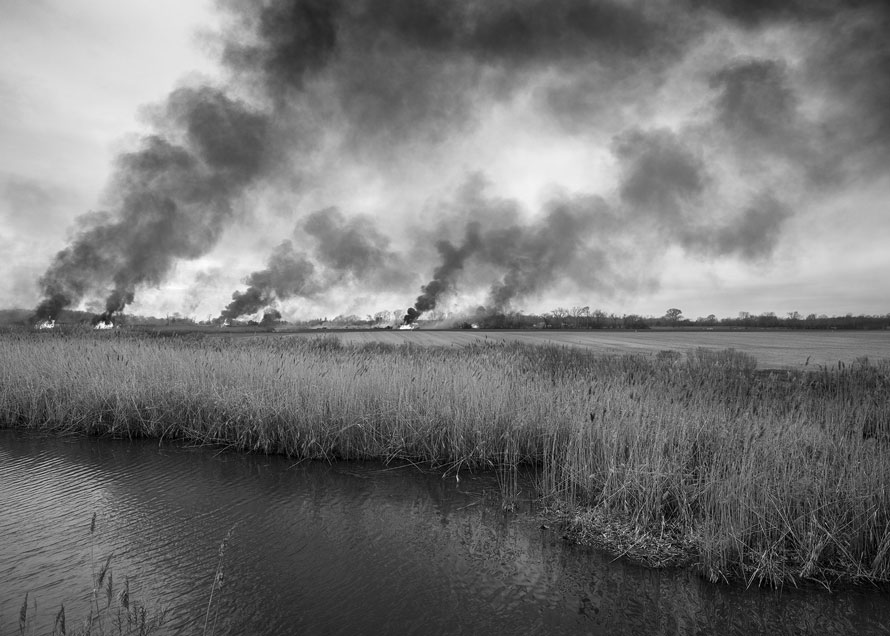
Edd – What projects are you currently working on? Any new projects in the pipeline?
Michael – I wouldn’t necessarily say there are any new projects in the pipe, but rather evolutions of existing work. I continue to explore my native area of Southern New Jersey. The idea of making a long-standing body of work about a familiar landscape or place is fascinating to me. It is something that evolves alongside your life, while you take root and raise a family, a process that changes our views with age. These life experiences change how we perceive things, the landscape included. It’s exciting to me to have a back burner project to step in and out of occasionally, that I don’t have to think about too much, but can occasionally revisit. It allows time for the oft-viewed, rarely seen landscape to rest, and my vision to watch the change and evolution of photographs, slowly take place. It’s a familiar place to test out ideas, to keep the tools sharp if you will.
Edd – One of the concerns that is often voiced by organizations devoted to historic preservation is “Where are the young people who will carry on this work?” Since you teach young photographers who are just starting out, I am curious if any of your students display any interest in documenting and interpreting the past, or are they more tuned in to the trendier aspects of contemporary photography.
Michael – It’s interesting; photo students seem to come wired with an interest of all things old, maybe it’s the historical connection with photographic traditions, perhaps it’s nostalgia, or the modern urban exploration phenomenon, but students do indeed incorporate these notions into their work in various ways. Some students focus on documenting industrial and social landscapes, and when they do, of course, we all (faculty) encourage them to find their voice and how they can use it to make a living. Every student is different, and you have to leave your work out of the equation, to ensure they understand why they are drawn to a subject, and not just teaching them to emulate someone else’s work without understanding why. It is a delicate balance, as landscapes and history are not for everyone, but I do think there is a contingent of young adults that will carry the torch in preservation. I also think the next generation of preservationists and hobbyists are bringing a significant change in how we present and share ideas and organize and socialize with groups.
Making photographs can often be mainly a solitary exercise, especially for me, wandering the ruins of a vanished railroad or other forgotten spaces in-between. Beyond image capture, processing is also a solo act, alone in a darkroom, studio or office. But photography doesn’t occur in a vacuum, and sharing results is key to the undertaking. This is the advantage the next generation of preservationists and hobbyists will have, the enhanced ability to find and organize social groups to present and share ideas. It’s this difference I think will keep the goals of documentation and preservation alive and well moving forward.
Edd – The curriculum at Drexel requires photography majors to learn film photography and darkroom processing. What do students in this digital age, many of whom have never been exposed to “analog” photography, make of this? And why do you think that learning what is now seen by many as obsolete, is important to their education?
Michael – We don’t teach a lot of film-based technique, but what we do teach is incredibly important to the education of a photographer. The most important benefit of a student working in large or medium format film is that it teaches the student to slow down – how to look, think, and craft an image on the ground glass, how to meter and expose, develop and print the negative. Regardless of the tool, it’s important to learn that every step in the process is intertwined. It’s not that these skills can’t be learned in digital, but learning film technique forces the issue, because the results are absolute. If you go through all the steps, run the film, and the negative is less than optimal, you have to do it again, attempting to figure out what you did wrong in your process. If you have a RAW file that is poorly exposed, there are still options to recover something. In short, with film, the stakes are higher. You can’t teach “too much” of the “how” and “why”, the critical thinking part of the process. It’s this that’s too easy to lose in a photographic education absent of the analog process. After mastering those problem-solving skills, whatever tool a photographer chooses from the tool box will be treated the same. Each format has its purpose, and today, there is nothing better or worse between them. Anyone arguing solely for the merit of film-based capture is romanticizing the process, and one asserting the supremacy of digital likely never understood or experienced what film is truly capable of. It’s a tool, just like the hammer. What matters, in the end, is how you use it.
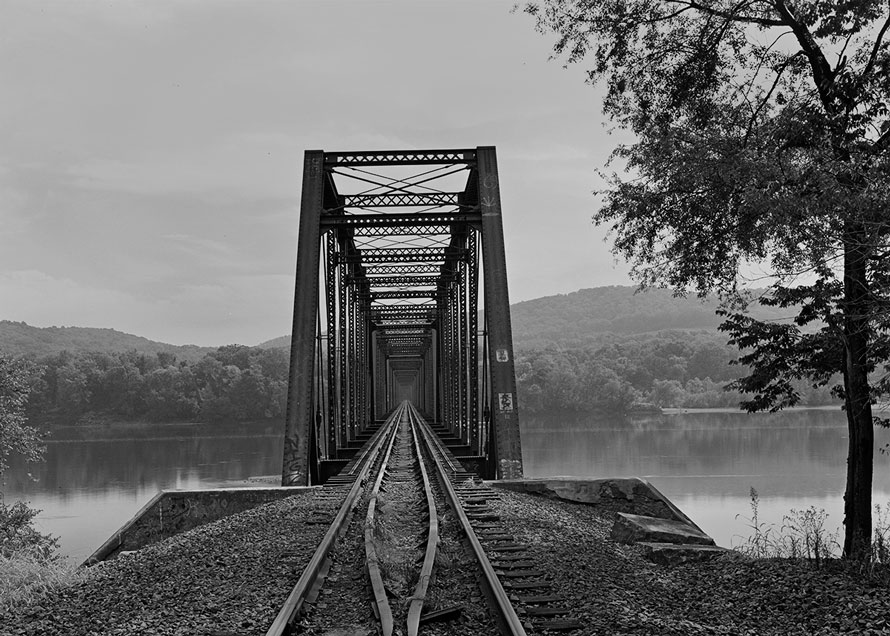
Edd – You have a strong affinity for black & white in your own work, and of course you still work with film. How do you think your work would be different if you were working in digital color?
Michael – I learned color in the darkroom during my education and never really felt connected to it, the process was limiting, and the introduction of color to a photograph brought a whole new layer of subjectivity to an image. Now that I shoot a good bit of work digitally, I do see my work in color, albeit briefly, and so far, it’s done nothing for me, my mind just tunes it out. I certainly admire what others are doing in color, and of course, the big names like Richard Misrach, Edward Burtynsky, and Robert Polidori are awe-inspiring, but I’m just not feeling it for my work. Much of my work is focused on places outside their times, adding color would change this significantly. It would be too connected to reality and the present.
Edd – Railroads are an unusually visual subject. Railfans are photographers almost by definition. I can’t think of any special interest that has as strong a connection to photography as railroading. Why do you suppose this is?
Michael – I think there are a lot of hobby groups that make a natural fit with photography; of avid hikers many landscape photographers are made, and birding another one, but yes, photography is indeed a prevalent predilection in the railfan community. The connection appears to goes back to preservation again, be it of moments, places or things; and nostalgia for the railroad generally, since subjects loaded with nostalgia seem to be prime targets. Sometimes they seek to answer questions: What was that branch line’s purpose? How many passenger trains stopped at this now dilapidated depot? Or express a regional fandom. Countless fallen flag railroads each have their cult following; in many cases, their fans never even saw the original road in operation. Fortunately for all of us interested in this genre, preservation by photograph has been intertwined with the railroad itself since the dawn of photography, creating a visual anthology of railroading by both professional and amateur photographers alike. Still today, the only thing constant in the railroad industry is change, and photography seems to be the most common form of preservation.
Outside of the simple “preservation by photograph” approach, some railfans try to emulate the greats like Shaughnessy, Plowden, Hastings, Steinheimer, and Link. That is a beautiful thing; it reflects an intelligent and passionate response to the visual proficiency of these noted photographers, who left an undeniable mark on the entire industry and hobby. Technology has also played a significant role in the advancement of the genre. The flexibility of higher level ISO sensitivity in digital, the extended dynamic range, instant feedback, and being limited by only the space on their memory card, photographers have advanced their rail photography to levels that would make some of the greats envious. The point is, what drives a lot of these people is passion, whether they are good at making photographs, or it is a simple visual record to model a structure, you really can’t deny the important intersection of railroads and photography in our community.
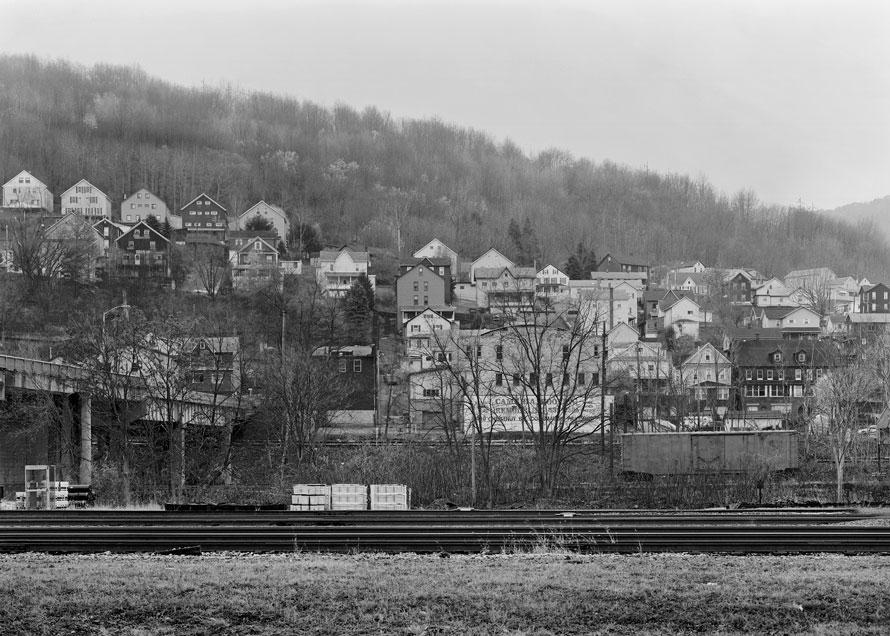
Edd – Do you have a favorite among your own photographs, one that is particularly meaningful to you? Tell us about it.
Michael – I am always hesitant to answer questions like this, but if I had to single one out, I’d say, Franklin Boro, from East Conemaugh, PA is pretty damn close. I remember seeing it on the ground glass, it was an image I made while I was reading Stilgoe’s Metropolitan Corridor, and it reinforces the connection between the railroad and the landscape. Layers of history stacked up on the mountainside, having seen an evolution of transportation and industrial history from those lofty views. Some would see a place like this as sad or depressing; I find these types of locations intriguing and beautiful. It’s a key image in the project.
Edd – And one last question. If you could spend a day photographing alongside any photographer from any era in the history of photography, who would it be, and why?
Michael – That is easy, William H Rau, however, I would need a little more than a day! I’d love to be in the meetings with PRR officials planning Rau’s campaigns in the 1890’s. To see what the expectations were from the client, and understand what Rau brought to the table, how they came to select the locations and the logistics of access. Being in the field would be interesting to see how they handled his photographic train and moving that incredibly bulky camera (his smallest was a 18×22” glass plate camera) all around an active railroad. I can only imagine some dispatcher pounding out messages on the telegraph telling the crew to move him along so he could get back to running trains!
Edd – I look forward to seeing where your exploration of the railroad landscape takes you, and thanks for letting us come along for the ride!
Michael – As always Edd, thank you, it’s a pleasure to be able to present my work like this, you don’t always have the opportunity to reflect back on your projects and ideas. This interview has been a great way to analyze my perspectives and assess how my ideas in photography and preservation have developed over the years. I know my approach to the subject is different from a lot of photographers interested in railroading, I hope this shed a little light on how and why I make the images I do. Thanks again for the opportunity, and keep up the great work on The Trackside Photographer!
Photographs and text Copyright 2017 – Michael Froio
Michael,
A very interesting and inspiring article, thank you for sharing your insight in regards to research, workflow, execution, consistency, and spontaneity. All very important words in the two projects I have taken on. I enjoy seeing the parallels, and differences, between our working methods.
I appreciate how your three website portfolios are interrelated, a centralized theme which you continue to expand on. Great ‘food for thought’ for me to better organize and realign my online presence.
So refreshing to hear the camera is just a tool, whether the medium is film or digital. In this world of megapixel races, sensor dynamic range and high ISO performance, it’s what the viewer sees and feels in the photograph, and not how it was created.
I admire your body of work, skills, drive, vision, and dedication; I’m happy to be on your email list and look forward to every new post.
Matthew